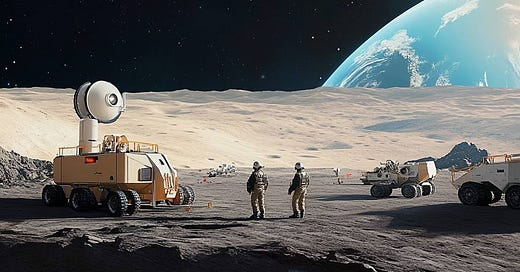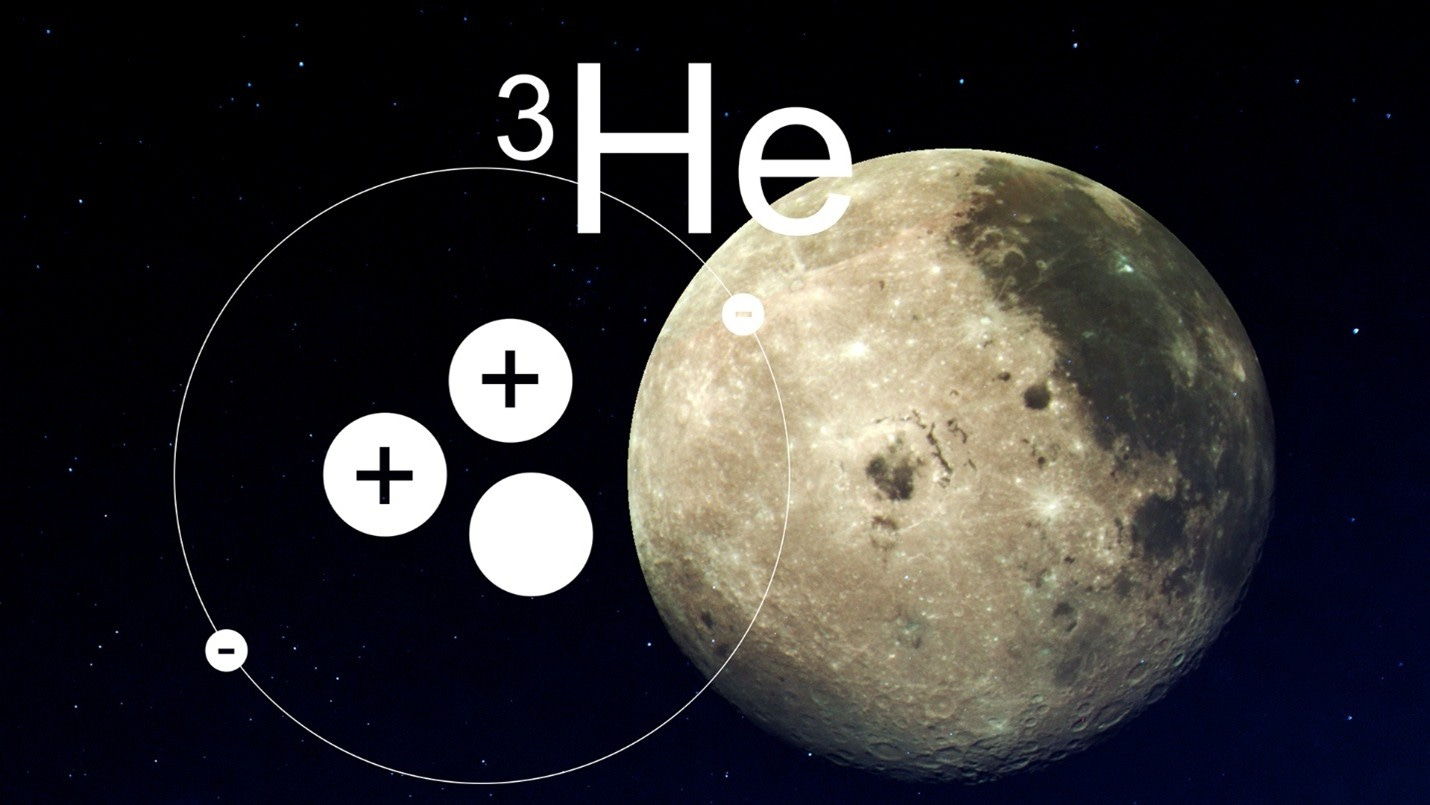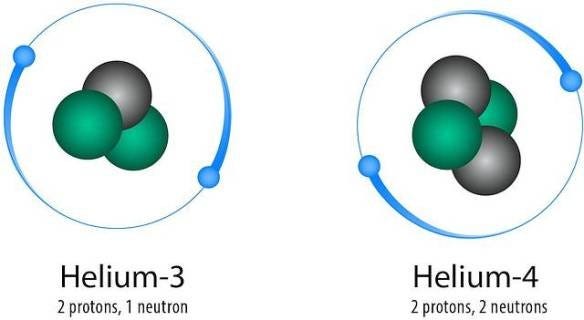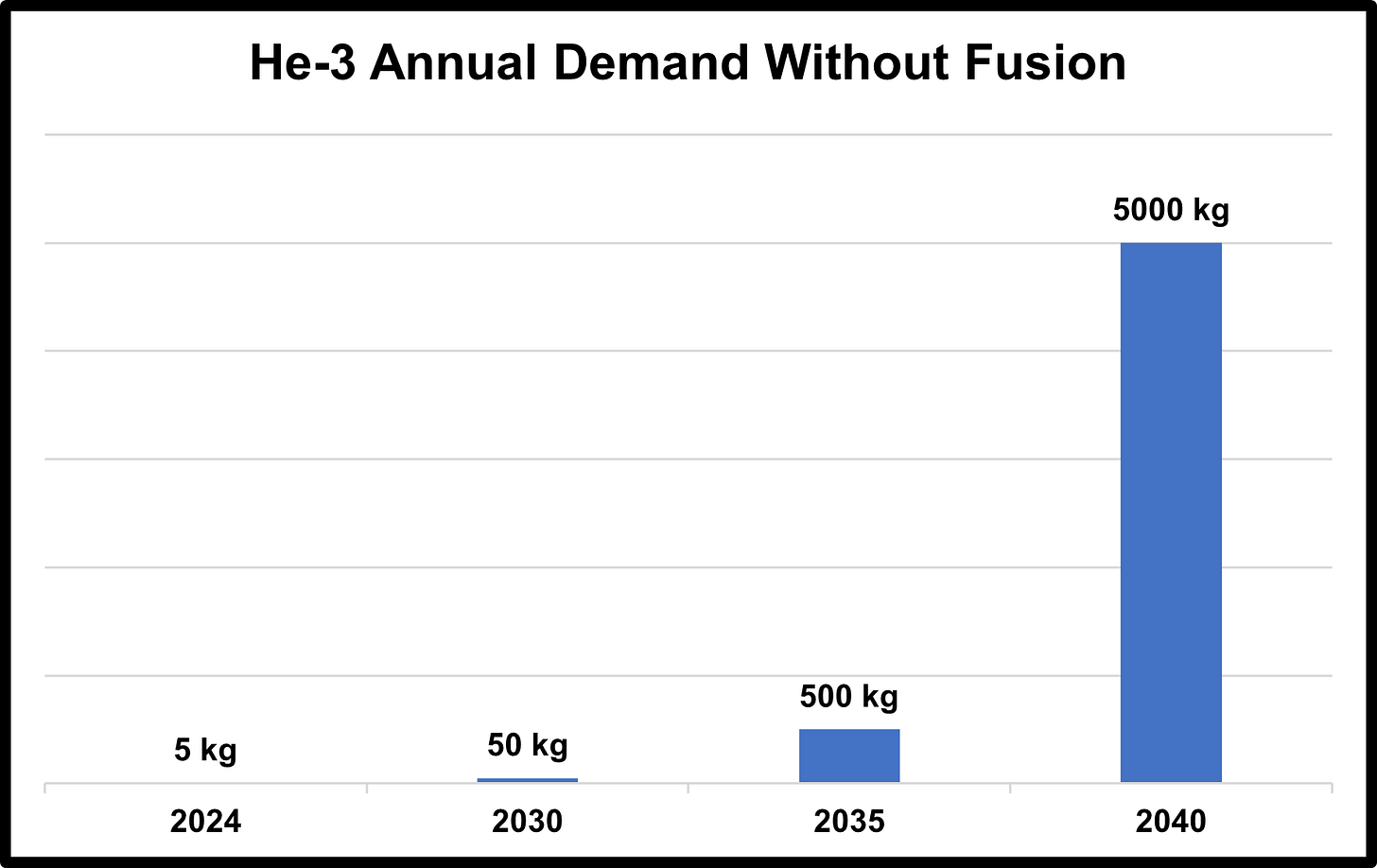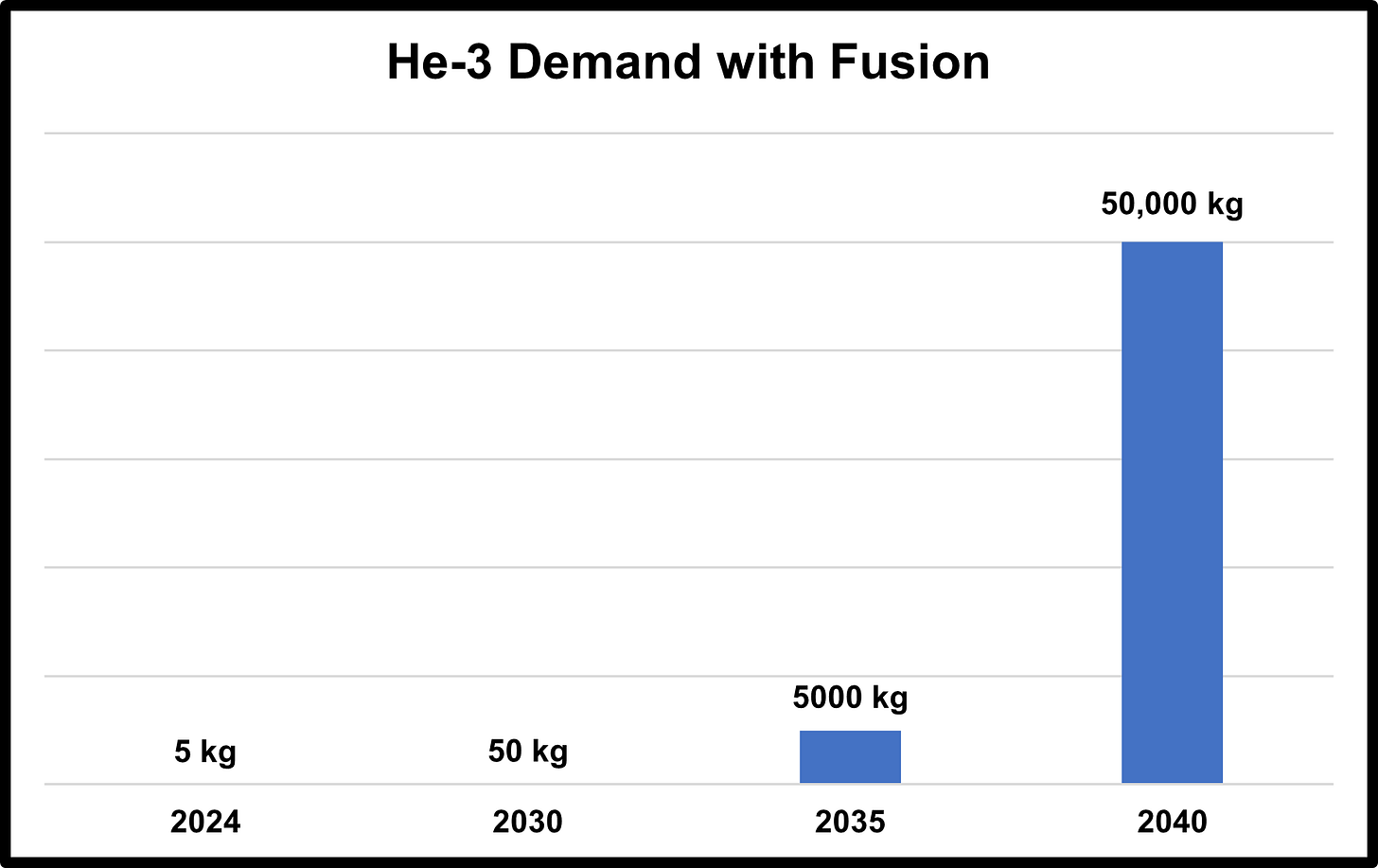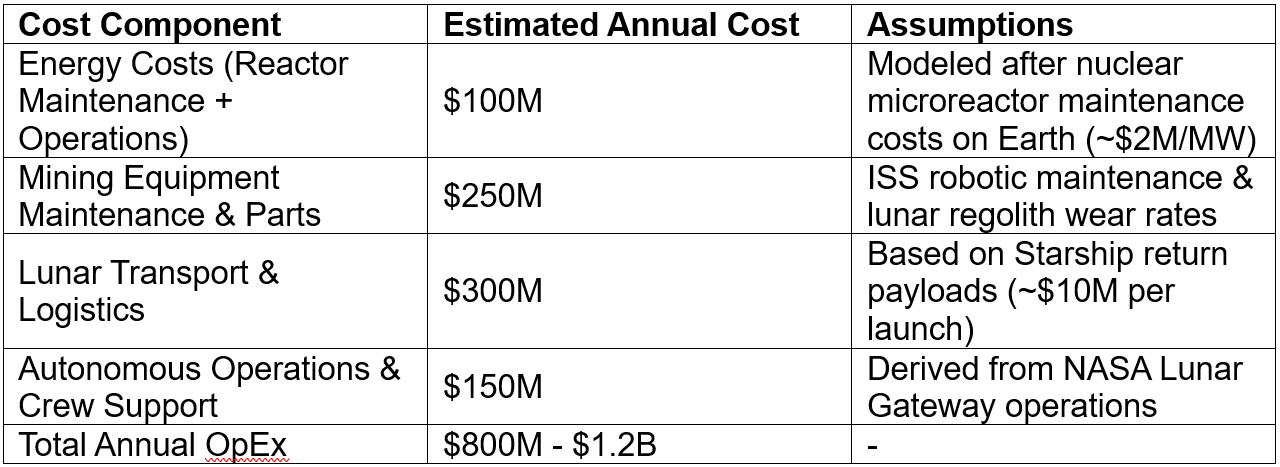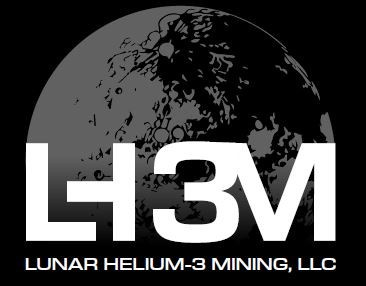The Helium-3 Imperative
Quantum computing, medicine, energy and the international race for the moon
The race to the moon is on. For the first time in 50 years, since the last Apollo landing in 1972, humans are returning to the moon. The world is entering a new era of lunar exploration and competition:
China led the charge with two successful sample return missions (Chang’e 5 in 2020, Chang’e 6 in 2024) and a third planned for next year (Chang’e 7 in 2026). China is rapidly advancing plans for a permanent lunar base.
Japan successfully achieved its first lunar landing in 2024 with the Smart Lander for Investigating Moon (SLIM) mission, making Japan the fifth country to accomplish a soft landing on the Moon.
In the US, the private sector has achieved major milestones with Intuitive Machines landing on the moon twice (tipping over on landing each time so far), and Firefly Aerospace successfully landing its Blue Ghost lander. In the government sector, the NASA Artemis program aims for a sustained human presence beginning with a crewed landing (in 2027 tentative).
This isn’t just about exploration; this is about who will control the Moon’s resources. The most valuable of these resources is probably He-3, an isotope that unlocks critical technology, is barely found on Earth, and is plentiful on the moon.
He-3 is a rare isotope with unique properties that make it an irreplaceable resource for next-generation technology. Unlike its abundant counterpart, He-4, which is used for MRI machines, semiconductor manufacturing, and superconducting magnets, He-3 is almost nonexistent on Earth – yet it is essential for the future of computing, medicine, and possibly energy. China has already announced plans to mine lunar He-3, positioning itself to control the supply of this critical element. The US. and its allies are working to establish their own lunar industrial infrastructure.
The world is on the verge of a revolution in quantum computing, but He-3 is a bottleneck to growth. Medical imaging has another application with potential for widespread routine use. He-3 could also play a role in cryogenics for data centers and computing via ultra-low temperature superconducting chips to increase efficiency and AI compute. Further on, the aneutronic fusion enabled by He-3 could allow clean and virtually limitless energy.
With minimal He-3 on Earth, the Moon is the only practical large-scale source. These technologies are ready to scale and He-3 is needed in quantity. Lunar mining is not an endeavor for a far-off vision, it is urgently needed now.
Table of Contents
A Rare Isotope with Enormous Potential
Helium-3 is a Bottleneck for Scaling Quantum Computing
Tritum Decay
Natural Gas Extraction
Quantum Computing Dilution Refrigeration
Medical Imaging – Hyperpolarized MRI
Cryogenics and Data Center Cooling
Neutron Detection and Security Applications
Terrestrial Production is Insufficient to Scale to Future Demand
The Moon is the Only Viable Source of Helium-3 at Scale
Market Size and Future Demand
Return on Investment
Interlune Corporation
The Extraterrestrial Mining Company (XMC)
Lunar Helium-3 Mining, LLC (LH3M)
A Rare Isotope with Enormous Potential
There are two Helium isotopes both critical for cryogenics and medical imaging; He-3 is exceedingly rare on Earth and enables unique capabilities (secretscotland.wordpress.com)
Helium is a noble gas known for its unique properties, including its low boiling point, inertness, and applications in cryogenics, aerospace, and medical technologies. Helium-4 (He-4) is the most common isotope, making up 99.999863% of Helium on Earth. Helium-4 is widely used in MRI machines, semiconductor manufacturing, and superconducting magnets. It is primarily obtained from natural gas deposits on Earth, where it accumulates over millions of years as a byproduct of radioactive decay.
A second isotope, Helium-3 (He-3) is exceedingly rare, making up 0.000137% of Helium on Earth – there are mere kilograms total on Earth. However, He-3 has unique nuclear and cryogenic properties that make it particularly interesting for quantum computing, medical imaging, and advanced aneutronic fusion energy. It enables ultra-low-temperature cooling essential for superconducting quantum computers, offers revolutionary possibilities in medical imaging through hyperpolarized MRI, and serves as a promising fuel candidate for future fusion reactors. However, its extreme scarcity on Earth makes its supply a major challenge.
Its potential uses combined with scarcity has led to growing interest in alternative sources, particularly from the Moon, where solar wind has deposited trace amounts of He-3 over billions of years (potentially billions of kilograms in total).
Extracting He-3 at scale is a bold mission. Earth-based sources are limited to byproducts of tritium decay from nuclear stockpiles and helium separation from natural gas. However, the potential for lunar mining is fueling interest in off-world resource extraction as a viable solution. Several space agencies and private enterprises have begun working toward mining lunar regolith, refining He-3, and transporting it back to Earth – another block in the building era of space industrialization.
Helium-3 is a Bottleneck for Scaling Quantum Computing
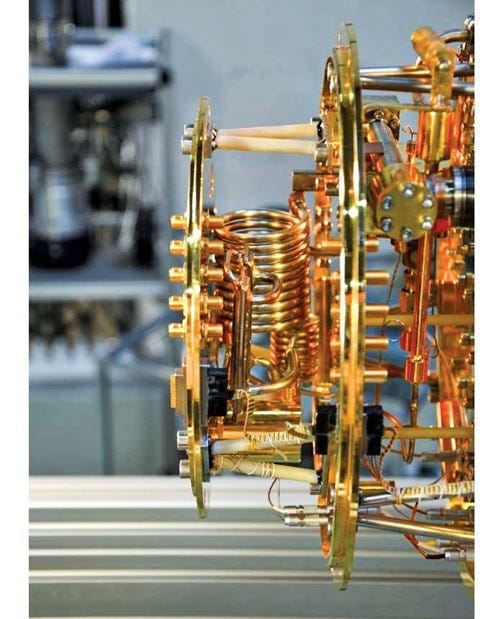
He-3 is an essential resource for quantum computing, which relies on superconducting qubits, which rely on ultra-low-temperature cooling to maintain coherence and function effectively. Unlike classical computers, which operate at room temperature, quantum processors must be kept at near absolute zero. Every major superconducting quantum computer – IBM, Google, D-wave – all require dilution refrigerators using He-3 for their quantum processors. There is no known alternative coolant that achieves the same millikelvin-level temperatures required for superconducting quantum computing.
Today, superconducting qubit counts are still small. For example, IBM’s best chips have about 1,000 qubits. Scaling up to commercially useful systems will require exponentially more He-3.
Unlike Helium-4, which can be extracted from natural gas deposits, Helium-3 has no significant natural reservoir on Earth. Its only sources today are:
Tritium Decay: Helium-3 is a byproduct of tritium decay, but tritium has a half-life of 12.3 years, meaning supply grows extremely slowly.
Nuclear Stockpiles: He-3 is extracted from aging nuclear warheads, but these stockpiles are shrinking and politically difficult to expand.
Natural Gas Deposits: Tiny amounts of He-3 exist alongside He-4 in natural gas, but these amounts are commercially insignificant.
Current annual He-3 production is estimated to be in the low tens of kilograms worldwide, with a global supply bottleneck that makes large-scale quantum computing impractical. Due to extreme scarcity, He-3 prices exceed $2,000 per liter, making its widespread use economically unfeasible. Without a reliable supply, quantum computing growth could be artificially constrained, slowing innovation in AI, cryptography, and materials science. Nations or corporations that secure He-3 supply chains will control the future of quantum computing.
With no scalable terrestrial production method, the estimated 1.1 million metric tons of He-3 in the lunar regolith is the only clear answer to solving the He-3 bottleneck.
Current Helium-3 Sources
Unlike He-4, He-3 has no significant terrestrial reservoir on Earth. It is primarily obtained through the decay of tritium, a radioactive isotope of hydrogen used in nuclear weapons and experimental fusion reactors.
Tritium Decay: Tritium is used in thermonuclear weapons, research reactors, and some fusion experiments. Tritium decays slowly with a half-life of about 12.3 years and produces He-3 as a byproduct. The US and other countries recover He-3 from aging tritium stockpiles. Although it is the primary supply of He-3 on Earth, this supply is extremely limited.
Natural Gas Extraction: Trace amounts of He-3 are in natural gas deposits with He-4, but these quantities are minuscule and not commercially viable as a primary source.
Current annual He-3 production is estimated to be in the low tens of kilograms worldwide, making it one of the scarcest and most expensive industrial gases on the market. Due to scarcity, prices exceed $2,000 per liter, making large-scale use economically challenging. Decommissioned tritium stockpiles, which are finite and shrinking Current supply is mostly derived from decommissioned tritium stockpiles, which are finite and shrinking. Unlike He-4, which is replenished via natural gas extraction, no known terrestrial process can generate significant amounts of He-3 outside of tritium decay. Unlike He-4, which is replenished via natural gas extraction, no known terrestrial process can generate significant amounts of He-3 outside of tritium decay.
Current Helium-3 Uses
Despite its scarcity, there are a few applications where He-3 is essential and irreplaceable.
1. Quantum Computing Dilution Refrigeration
He-3 is a critical component of dilution refrigerators, which can reach temperatures below 10 millikelvin – far colder than deep space. Quantum computers use superconducting qubits, which must be kept at near absolute zero to maintain quantum coherence – even tiny amounts of heat can disrupt qubit coherence. Tech companies and research labs working on quantum computing, such as IBM, Google, and D-Wave, rely on He-3 for cooling their quantum processors.
Dilution refrigeration is the primary method for achieving these ultra-low temperatures. It works because of the unique phase separation of He-3 and He-4 at low temperatures, which creates a cooling effect that is not possible with He-4 alone. He-3 is critical for quantum computing; the current scarcity is a likely bottleneck for the expansion of quantum computing, limiting the number of quantum processors that can be built. Establishing He-3 supply will be as critical to computing in the future as semiconductors are now.
The quantum computing market was estimated at $1-2 billion in 2024, projected at $50 billion by 2030, and has potential to go to $500 million-$1 trillion in the 2040s if scaled for commercial and enterprise applications.
2. Medical Imaging – Hyperpolarized MRI

He-3 is used in specialized hyperpolarized MRI lung scans. Unlike conventional MRI, which visualizes soft tissues using water molecules, hyperpolarized He-3 gas allows for high-resolution imaging of airways and lung function, making it valuable for diagnosing or assessing pulmonary diseases like COPD, asthma, and cystic fibrosis. Xe-129 can serve this purpose but it doesn’t visualize small airways as well and causes sedation. Xe-129 does have an advantage in showing perfusion across the lungs into the blood, which, when combined with more availability to develop the technology now, could make it take the lead in this type of imaging. Still, He-3’s ability to get to small airways likely ensures a meaningful role in the future. Though not yet widespread due to cost constraints, this application could expand dramatically with availability of He-3 to a large market as several hundred million people are effected by these common diseases.
3. Cryogenics and Data Center Cooling
As data center energy consumption grows, the need for advanced cooling solutions is rising. He-3’s superior cryogenic properties, compared to He-4, make it an attractive option for next-generation low-temperature computing. Future superconducting data centers could use dilution refrigeration to reduce power consumption and increase efficiency, while increasing AI compute.
4. Neutron Detection and Security Applications
He-3 is highly effective in neutron detectors, which are used for border security and nuclear nonproliferation efforts to detect smuggled nuclear materials. Since neutrons pass through most materials but interact with He-3, it is a preferred detection medium for radiation monitoring devices.
Terrestrial Production is Insufficient to Scale to Future Demand
A potential competitor supply of He-3 could exist on Earth via Tritium decay in current supplies or via Tritium production (and subsequent decay) in CANDU reactors. Analysis shows that neither of these sources is sufficient to scale to anticipated demand.
CANDU reactors are a Canadian design that uses heavy water (D₂O) as a moderator and coolant and produces small amounts of Tritium byproduct that is routinely extracted. This bred Tritium makes up the bulk of the global Tritium stockpile. There are about 31 of these reactors in Canada and another 18 similar units in India. All of these reactors combined produce about 2 kg of total He-3 annually (kleinmanenergy.upenn.edu).
Meeting the projected annual demand (without fusion) of 5000 kg would require thousands of these reactors. The scale required to meet future demands is impractical with current technology and infrastructure. With over a trillion kg of He-3 on the moon, lunar mining, despite its challenges, presents a more feasible solution to satisfy the anticipated helium-3 requirements.
The Moon Is the Only Viable Source of Helium-3 at Scale
Unlike He-4, which is extracted from natural gas deposits on Earth, He-3 does not accumulate naturally in any significant terrestrial reservoir. The only substantial supply exists on the Moon, where billions of kilograms of He-3 are embedded in the lunar regolith, deposited over billions of years by solar wind. While mining and extracting this resource is a formidable challenge, it may be the only scalable solution to meeting the growing demand for He-3 in quantum computing, medicine, and potentially fusion energy.
Both China and the US have recognized the strategic potential of He-3. China has explicitly stated its interest in lunar mining as part of its long-term space plans. The US National Quality Initiative (NQI) aims to accelerate development of quantum computing including efforts to source He-3 from the moon. Meanwhile, private companies are beginning to lay the groundwork for commercial lunar resource extraction, seeking to turn He-3 into an accessible and transportable commodity.
The Moon’s lack of atmosphere allows solar wind to directly impact the surface, where it embeds small amounts of Helium-3, hydrogen, and other elements into the top layers of lunar dust. Over billions of years, a vast but highly diffuse deposit of He-3 has accumulated across the Moon’s surface. The estimated concentration of He-3 in lunar regolith is between 4 and 20 parts per billion (ppb), requiring the processing of large quantities of material to extract meaningful amounts of He-3. Estimates are that 1.1 million metric tons of He-3 exist across the lunar surface, with particularly high concentrations in the lunar maria and regions near the poles where regolith exposure to solar wind has been longest. He-3 is mainly found in the top few meters of the lunar surface; this is where mining efforts would focus, stripping and processing large amounts of regolith.
Despite its abundance, extracting He-3 from the Moon presents major technological and logistical challenges:
Low Concentration: Unlike traditional mining, He-3 is not found in veins or concentrated deposit – it is diffusely spread throughout lunar dust, requiring high-throughput processing of regolith.
Energy-Intensive Processing: He-3 extraction requires heating regolith to 600-900°C to release trapped gases. This demands a high-energy input, raising questions about how to power such an operation on the Moon.
Lunar Dust Hazards: The fine, electrostatically charged nature of lunar regolith poses serious challenges to mining equipment, as it can degrade machinery and clog systems.
Logistics & Transportation: Even if He-3 is successfully extracted, it must be stored, liquefied, and transported back to Earth – an expensive and complex supply chain issue.
To overcome these challenges, several approaches to He-3 mining have been proposed:
Microwave or Solar Heating: Using solar concentrators or microwaves to heat regolith and release trapped He-3.
Electrostatic Beneficiation: Using charge-based separation techniques to isolate He-3-rich particles from regolith before heating.
Robotic Mining Systems: Deploying autonomous rovers to excavate and process regolith with minimal human oversight.
In-Situ Resource Utilization (ISRU): Utilizing lunar materials (such as oxygen and metals) to support the infrastructure of technologies that would use the He-3, reducing the need to transport supplies from Earth.
Several national space agencies and private companies are working to develop lunar resource extraction capabilities:
China: Plans to establish a permanent lunar base by the 2030s, with He-3 mining explicitly stated as a long-term goal.
NASA & Artemis Partners: The U.S. is developing lunar landers and robotic systems to lay the foundation for future lunar resource utilization.
Private Companies Focused on He-3 Mining:
Interlune – A startup focused on helium extraction from lunar regolith.
XMC (Extraterrestrial Mining Company) – A NYC-based company targeting off-world mining, including He-3.
Lunar Helium-3 Mining – Spun out of doctoral work in Arizona and subsequent technology patent.
If lunar He-3 mining becomes viable, it could unlock an entirely new space-based lunar economy, where the Moon becomes a hub for critical materials extraction and advanced technology production. The race to control He-3 is not just about energy - it is about quantum computing dominance, medical advancements, and securing a key strategic resource for the 21st century.
Financial Model
Market Size and Future Demand
The most certain and essential driver of He-3 demand is quantum computing. He-3 is essential for the cooling needed for quantum computing, and quantum computing is essential for cryptographic and compute competitiveness; this makes scaling the He-3 supply a strategic imperative regardless of price.
Google aims to build a useful error-corrected quantum computer by 2030, implying a 100X growth in qubit count by 2035 (Google AI Quantum Research).
IBM projects scaling from about 1,000 qubits today to over 1 million qubits (1000X) by 2040, requiring significant He-3 for dilution refrigeration (IBM Quantum Roadmap).
According to a 2024 McKinsey report, the quantum market is expected to grow from $1-2 billion in 2024 to $50 billion by 2030 (25-50X) and up to $1 trillion by 2040 (500-1000X) (McKinsey Quantum Report).
Medical Imaging (Hyperpolarized MRI) and cryogenics for data centers and AI will be additional demands that will certainly increase with increased supply in addition to quantum, and be widespread in use (Radiology Society of North America 2024 - He-3 MRI is limited today by supply, not technology, and could see broad adoption if He-3 becomes more available, Intel and IBM Roadmaps for Cryogenic Computing - Superconducting AI chips may require millikelvin cooling, increasing He-3 demand for future data centers).
He-3 currently sells for about $2,500 per liter and the market is $125 million annually (5 kg sold per year). A moderate assumption based on the aforementioned technologies is 10X demand by 2030, 100X by 2035, and 1000X by 2040.
If fusion energy becomes viable, Helium-3 demand would dwarf all other applications combined.
He-3 fusion has long been theorized as a clean, aneutronic energy source, but reactor technology is still in early stages.
If He-3 fusion were to become commercial, demand would jump to tens of thousands of metric tons per year, vastly exceeding any foreseeable supply.
Lunar mining would be essential to sustain a He-3-powered energy economy.
He-3 fusion reactors, when combined with deuterium, offer aneutronic fusion, solving a materials science issue and reducing radioactive equipment waste. However, achieving the necessary conditions for this type of fusion requires significantly higher temperatures and advanced confinement methods compared to more fusion reactions like deuterium-tritium that are currently in development. US and European roadmaps estimate that this type of fusion could become operational in the next few decades. Significant technical challenges remain. Current startups, Helion Energy and Pacific Fusion, are based on He-3 reactions.
If He-3 based fusion energy is achieved in the next few decades, a projected demand of 5,000 kilograms of He-3 by 2040 is reasonable.
With or without aneutronic fusion, He-3 is not a speculative market – it is an immediate strategic priority for technological dominance in quantum computing, at a minimum. The bottleneck for He-3 is not demand, it is supply. Lunar mining solves this critical issue.
Return on Investment
Capital Expenditures – One-time investment required to set up lunar mining operations
Operational Expenditures – Recurring costs per year to keep mining operations running
Revenue and Market Size Assumptions
ROI Model Insights
Initial capital expenditures ($2.25B) recovered around 2035-2040.
Annual profits exceed $100B by 2040 if demand reaches 5000 kg/year.
Biggest risk factors: Mining equipment longevity, transport logistics, alternative He-3 sources (Tritium breeding).
With aneutronic fusion, profits reach trillions of dollars.
Company Profiles
Interlune Corporation
Interlune was founded in 2020 specifically to mine He-3 from the Moon. They are based in Seattle, WA. They have developed proprietary technology for the excavation, sorting, extraction, and separation of lunar regolith. Their harvester is designed to be smaller, lighter, and more energy-efficient than existing concepts, requiring ten times less power. This innovation reduces transportation and operational costs on the Moon.
Interlune's founding team brings world-class deep expertise in aerospace engineering and resource extraction:
Rob Meyerson (Co-Founder and CEO) – Aerospace engineer and executive who served as President of Blue Origin from 2003 to 2018. Oversaw the development of the New Shepard and New Glenn launch systems. Previously held senior positions at Kistler Aerospace and NASA's Johnson Space Center. He has a BS in Aerospace Engineering from the University of Michigan and a MEM from the University of Houston.
Gary Lai (Co-Founder and CTO) – Aerospace engineer who was the chief architect of Blue Origin's New Shepard suborbital launch vehicle. He flew aboard New Shepard's 20th mission, NS-20 in 2022, and was a founding employee of Blue Origin in 2004. He has a BS in Applied Economics and Business Management from Cornell University and a BSE in Aeronautical and Astronautical Engineering from the University of Washington.
Harrison Schmitt (Co-Founder and Executive Chairman) – Geologist and former NASA astronaut, who walked on the Moon during the Apollo 17 mission in 1972. He served as a US Senator from New Mexico from 1977 to 1983. He has been a long-time advocate for lunar resource utilization, particularly the extraction of helium-3, and authored "Return to the Moon," outlining a business plan for lunar resource development. He has a BS in Geology from the California Institute of Technology, studied at the University of Oslo as a Fullbright Scholar, and has a PhD in Geology from Harvard University.
Indra Hornsby (Co-Founder and COO) – Aerospace executive and commercial space lawyer who held senior roles at companies including MDA, Rocket Lab, and Spaceflight Industries. She has a BAH in International Security and Economics from Queen’s University, an MBA from the University of Leicester, and a JD from the University of Victoria.
James Antifaev (Co-Founder and Head of Product) – Business development professional with experience at companies including Maxar and Google. He has a BASc in Engineering from the University of British Columbia and a MSc in Business Administration, Management, and Operations from the International Space University.
Interlune has secured a combination of private investment and government funding, and has raised a total of $17.7 million:
September 2022 Pre-seed Round ($1.9M)
October 2023 NSF SBIR Phase I
February 2024 Seed Round ($15.5M)
July 2024 NASA TechFlights grant ($348K)
October 2024 US DOE grant ($365K)
The company aims to leverage advancements in in-situ resource utilization (ISRU) and robotic mining to enable commercial-scale He-3 extraction from lunar regolith with the ultimate goal to establish a sustainable supply chain of helium-3 for terrestrial applications. The company is developing proprietary techniques to extract He-3 and other volatiles from the lunar soil. Their approach involves thermal extraction, heating regolith to over 700°C to release trapped helium and other noble gases. They intend to deploy autonomous robotic systems to efficiently collect and process lunar regolith, while developing on-orbit storage and handling capabilities to maintain He-3 purity.
The Extraterrestrial Mining Company (XMC)
XMC was founded in 2023 and is based in New York City. The company is focused on large-scale lunar resource extraction, including a focus on He-3. The founding team brings experience from finance, space business and geologic science:
Glen Martin (Founder & CEO) – Previous CEO of Hyox Inc, founder of Infrastructure Energy and Pod Generating Group. He also co-founded ProtoStar (which successfully launched two direct-to-TV satellites that were later bought by Intelsat). He had previously worked on the ISS design at McDonnell Douglas. He has a Btech in Aerospace Engineering from Toronto Metropolitan University and an MBA from the University of Southern California.
Ruby Patterson (Chief Scientist) – A former NASA scientist and space industry consultant. She has a BS in Geology from the University of Texas San Antonio, an MS in Geology from the University of Arkansas, and a PhD in Geology.
Rob Lundstrom (CFO) – Experienced financial industry executive. He has a BS in Accounting and Sports Studies from Indiana State University and an MBA from Virginia Commonwealth University.
Michael Hewins (EVP General Counsel) – Former Deputy CEO, COO of NewSat Ltd and Chairman and CEO of Astrovision Inc. He has previous experience supplying space insurance to major satellite operators. He has a BA from Wake Forest University and a JD from Suffolk University.
The company vision is to develop lunar mining operations with autonomous systems and ISRU to supply He-3 for Earth.
Lunar Helium-3 Mining, LLC (LH3M)
LH3M was founded in 2023 and is based out of Scottsdale, AZ. The company is focused on developing practical technologies for detecting and extracting lunar He-3, aimed at supplying future aneutronic fusion energy. The company and founder hold several relevant patents including for a debris clearing rover, gas separation, extraterrestrial particle imaging, cryogen chamber, and mass spectrometry for locating mining sites.
Chris Salvino (CEO and Chief Engineer) – Former corporate and military pilot, F-16 flight surgeon in the Indiana National Guard, and test pilot. A surgeon with Doctors Without Borders with many deployments during over three decades working as a trauma surgeon. He later led SharpMed, LLC medical supplier as CEO before founding L3HM. He has many degrees including a BS in Biology from the University of Notre Dame, MD from Loyola University Chicago Stritch School of Medicine, and Aerospace Engineering graduate degrees. He is currently working on a PhD with a focus on lunar mining and mineral engineering at the University of Arizona.
LH3M is noting the development of a lunar mining system with new techniques, different than terrestrial mining systems, with minimal moving parts for efficiency and durability. These systems mitigate challenges unique to the moon including lunar dust. The company was initially internally funded during which time the initial technology was developed and patented. The company now aims seek capital investment to support hardware development.
Conclusion
The race for He-3 is not just a scientific endeavor and it is not speculative based on fusion. For quantum computing to scale, it appears most likely that He-3 is a critical bottleneck for the associated cryogenics. The establishment of a He-3 supply chain will realize other technologic capabilities, and will enable second generation clean fusion which would then cause a second wave of demand rise for He-3.
Quantum computing holds promise to revolutionize cryptography and compute.
There is promising medical imaging technology ready to implement if a supply of He-3 becomes available.
If aneutronic fusion becomes an energy source, demand for He-3 would explode even beyond the robust growth expected from quantum computing, data centers, AI, and medicine.
China has explicitly stated its ambitions to extract He-3 from the Moon, and has a rapidly developing lunar capability.
Companies like Interlune, XMC, and LH3M represent more pioneering efforts in the burgeoning new space economy to move beyond low-earth orbit and into harvesting off earth resources. Market projections suggest robust demand and urgent need, while the quantum computing implications suggest a strategic imperative for the US.

